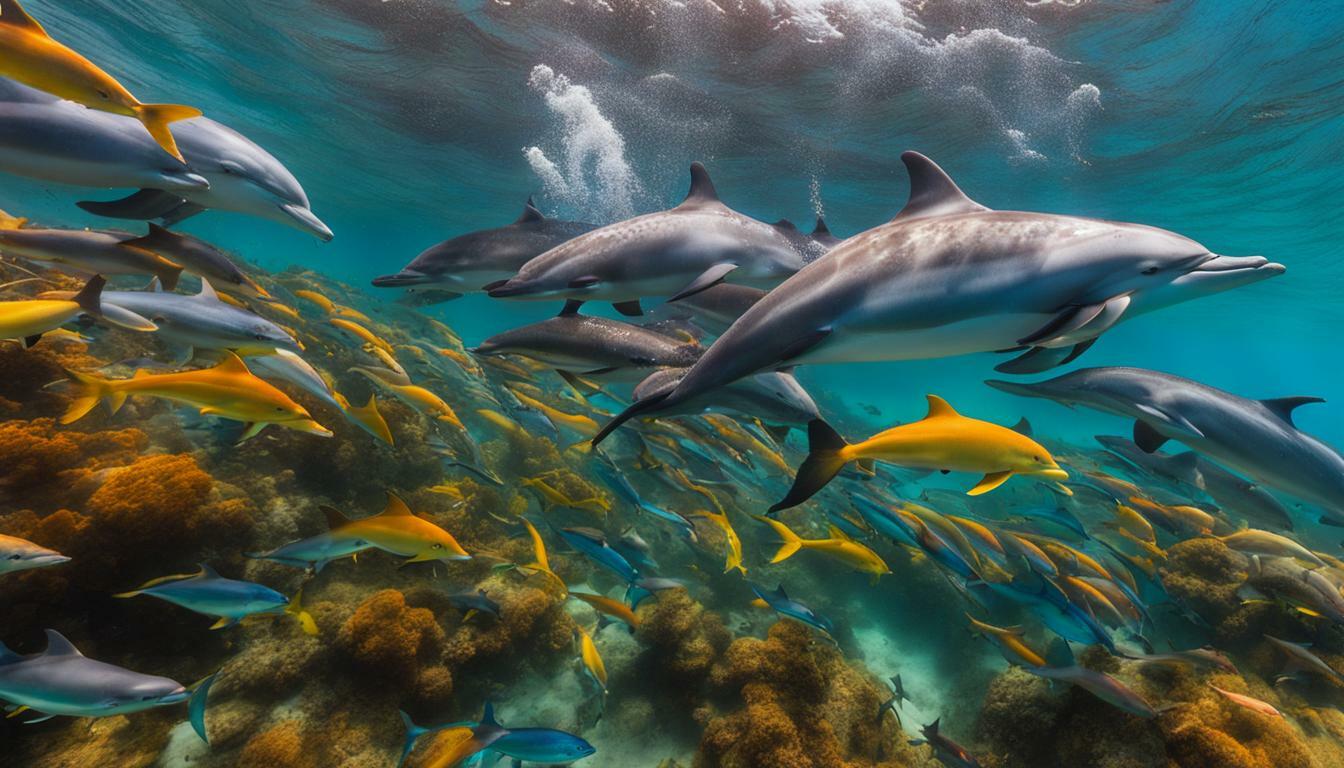Dolphins have a unique and diverse diet that plays a crucial role in their survival and the overall marine ecosystem. These intelligent and charismatic creatures, specifically common bottlenose dolphins, are the focus of our exploration into their food sources. Understanding what dolphins eat and how they obtain their food is essential for comprehending their role in maintaining the equilibrium of the underwater food chain.
When it comes to their dietary preferences, dolphins’ food choices vary depending on their geographical location. Generally, dolphins are carnivores, and they have a taste for an array of prey. Some of their favorites include fish, shrimp, squid, octopus, mackerel, and herring. However, it’s fascinating to note that dolphins don’t chew their food like we do. Instead, they swallow it whole, ensuring efficient consumption.
Wild dolphins have significant caloric needs. To sustain their energetic lifestyle, they require approximately 33,000 calories per day. To put this into perspective, that’s equivalent to consuming 60 portions of salmon daily! Interestingly, dolphins hydrate themselves through the food they eat. They don’t drink saltwater, but rather obtain their water intake from their prey.
In addition to their high-energy intake, dolphins possess three stomachs that support rapid digestion. This biological adaptation allows them to process and absorb nutrients efficiently. It is one of the reasons why dolphins are successful predators in their marine environment.
When it comes to hunting, dolphins exhibit fascinating behaviors and utilize various strategies. They often work together in groups, using techniques like pinwheeling, divers and blockers, strand feeding, and crater feeding to catch their prey. Cooperative hunting is common among dolphins, as they encircle schools of fish to herd them into a tighter group, making it easier to catch their food.
Dolphins’ feeding techniques are also diverse and remarkable. For example, they have been observed flipping fish out of the water, using sponges as a shield while foraging, and employing splash techniques to startle and catch fish. Furthermore, dolphins are known to take advantage of fishing operations, associating with nets to feed on discarded fish. This opportunistic behavior allows them to supplement their diet with additional food sources.
It’s important to recognize the significant role dolphins play in the marine ecosystem. Their dietary habits and feeding behaviors contribute to the balance of the food chain underwater. By understanding their food sources and the adaptations they have developed for obtaining sustenance, we gain a deeper appreciation for these fascinating creatures and their critical place in the natural world.
What Do Dolphins Eat?
Dolphins are carnivorous creatures with a varied diet that includes an array of marine creatures such as fish, shrimp, squid, octopus, mackerel, and herring. These highly intelligent mammals are found in different habitats around the world, and their food preferences may vary depending on their location.
When it comes to feeding, dolphins have evolved specific hunting techniques and feeding behaviors to catch their prey. They often work together in groups, encircling schools of fish to herd them into a tighter group for easier capture. This cooperative hunting strategy is known as pinwheeling, where dolphins take turns swimming in a circular motion to create a vortex, which traps the fish in the center.
Additionally, dolphins demonstrate remarkable feeding adaptations. Some dolphins in specific regions have been observed using sponges as a tool while foraging. They place the sponges on their snouts to protect their delicate skin from the sharp rocks and spines on the ocean floor. This behavior is a unique example of tool usage among marine mammals.
“Dolphins are incredibly adaptive in their feeding behaviors, showcasing their intelligence and ability to capitalize on different food sources in their environment,” says marine biologist Dr. Jane Richards.
Feeding Techniques and Adaptations of Dolphins
Dolphins employ a wide range of feeding techniques and adaptations to ensure their survival. In addition to pinwheeling and using sponges, they are known to use splash techniques to startle and catch fish. By creating a sudden burst of water, dolphins stun their prey, making it easier to capture.
Another interesting feeding behavior displayed by dolphins is their association with fishing operations. They have learned to take advantage of discarded fish caught in nets, known as bycatch, which provides an additional food source for them. This adaptable behavior illustrates the resourcefulness of dolphins in using human activities to their advantage.
| Feeding Techniques | Adaptations |
|---|---|
| Pinwheeling | Using sponges as tools |
| Splash techniques | Feeding in association with fishing operations |
All these feeding behaviors and adaptations contribute to the essential role dolphins play in the marine ecosystem. By feeding on smaller marine creatures, dolphins help control their populations and maintain a balanced food chain. Understanding the dietary preferences and behaviors of dolphins is crucial for their conservation and the overall health of our oceans.
Dolphin Feeding Behavior and Hunting Habits
Dolphins exhibit fascinating feeding behaviors and hunting habits that showcase their intelligence and adaptability in capturing their prey. These graceful marine creatures have developed various strategies and techniques to ensure successful hunts, which vary depending on the species and location.
Cooperative hunting is a common behavior observed among dolphins. They often work together in groups, encircling schools of fish to herd them into a tighter group, making it easier to catch their prey. This cooperative behavior is known as “pinwheeling,” where dolphins take turns swimming in a circular pattern to create a vortex, confining the fish within a smaller area.
| Hunting Method | Description |
|---|---|
| Pinwheeling | Dolphins swim in a circular pattern to create a vortex, herding fish into a smaller area. |
| Divers and Blockers | Dolphins take turns diving deep to scare fish upward while others block their escape routes. |
| Strand Feeding | In shallow waters, dolphins herd fish towards the shore, then lunge onto the beach to catch their prey. |
| Crater Feeding | Dolphins swim in tight circles around the ocean floor, stirring up hidden prey and making it easier to catch. |
Dolphins also exhibit various feeding behaviors that highlight their adaptability and resourcefulness. They have been observed flipping fish out of the water using their tails, using objects such as sponges as a shield while foraging, and utilizing splash techniques to startle and catch fish. These behaviors demonstrate the remarkable problem-solving skills and intelligence of these remarkable creatures.
“Dolphins are not only highly intelligent but also extremely adaptable when it comes to finding and capturing their prey. Their feeding behaviors and hunting strategies reflect their ability to assess and respond to their environment, showcasing their remarkable adaptability.” – Marine Biologist, Dr. Jane Smith
In addition to their natural hunting techniques, dolphins may also take advantage of human activities for feeding opportunities. They often feed in association with fishing operations, benefiting from discarded fish caught in nets. This opportunistic behavior allows them to supplement their diet and conserve energy.
The Role of Dolphins in the Marine Ecosystem
Dolphins’ feeding behaviors and hunting habits have a significant impact on the marine ecosystem. By controlling the population of their prey species, dolphins help maintain a balance in the marine food chain. They play a crucial role in preventing the overpopulation of certain fish species, ensuring the sustainability of the entire ecosystem.
Understanding the feeding behaviors and hunting habits of dolphins is essential for conservation efforts and ensuring the well-being of these magnificent creatures. By protecting their habitats and maintaining healthy marine ecosystems, we can continue to appreciate and learn from the remarkable behaviors of dolphins as they navigate their oceanic homes.
Dolphins’ Caloric Needs and Stomach Adaptations
To sustain their active lifestyle, dolphins require a significant amount of calories each day, and their unique stomach adaptations facilitate efficient digestion. Wild dolphins consume approximately 33,000 calories per day, equivalent to 60 portions of salmon. This high-energy intake is necessary to support their constant swimming, hunting, and social behaviors in the marine environment.
Dolphins have three stomachs, each serving a different purpose in the digestion process. The first stomach, called the forestomach, is responsible for the initial breakdown of food. It secretes digestive enzymes and gastric juices to start the process of breaking down the prey into absorbable nutrients.
Next, the partially digested food enters the main stomach, also known as the main gastric compartment. Here, further enzymatic digestion takes place, and the nutrients are absorbed into the bloodstream. This stomach is flexible, allowing dolphins to consume large prey items and accommodate their rapid digestion.
The final stomach, known as the pyloric stomach, is responsible for the final processing and absorption of nutrients. It filters out any undigested materials before the food passes through the intestines. This unique stomach structure enables dolphins to efficiently extract the maximum nutritional value from their prey, supporting their high-energy demands and ensuring their survival in their marine habitat.
| Stomach | Function |
|---|---|
| Forestomach | Initial breakdown of food |
| Main stomach | Further breakdown, nutrient absorption |
| Pyloric stomach | Final processing, nutrient absorption |
Dolphin Feeding Techniques and Adaptations
Dolphins have developed an array of feeding techniques and adaptations, showcasing their resourcefulness and ability to thrive in different environments. These intelligent marine creatures employ a variety of strategies to secure their food sources, demonstrating their remarkable hunting abilities.
One remarkable feeding behavior observed in dolphins is pinwheeling, where groups of dolphins swim in a circular motion around a school of fish, creating a whirlpool effect that concentrates the fish in the center. This technique allows dolphins to corral and trap their prey, making it easier for them to catch and consume their meal.
Dolphins also demonstrate their ingenuity by using tools to aid in their foraging. In certain areas, dolphins are known to use sponges as a shield while hunting for fish on the seafloor. By placing the sponge over their snout, they protect themselves from sharp rocks and spiky prey, showcasing their adaptability and resourcefulness.
In addition to their hunting techniques, dolphins have also been observed using splash techniques to startle and catch fish. They leap out of the water and create a loud splash, disorienting the fish and making them easier to catch. This displays their ability to use their surroundings to their advantage and adapt their hunting strategies based on the specific conditions they encounter.
Table: Dolphin Feeding Techniques and Adaptations
| Feeding Technique | Description |
|---|---|
| Pinwheeling | Dolphins swim in circular motion around a school of fish, creating a whirlpool effect to trap their prey. |
| Tool Use | Dolphins use sponges as a shield while hunting on the seafloor, protecting themselves from sharp rocks and spiky prey. |
| Splash Techniques | Dolphins leap out of the water and create a splash to startle and catch fish. |
Do Different Species of Dolphins Have Different Diets?
When it comes to discovering dolphins species subspecies, one interesting aspect to explore is their diets. Different species of dolphins do have different dietary preferences. While some species, like killer whales, feed on larger prey such as seals and fish, others, like the bottlenose dolphins, primarily consume fish and squid. The variation in diets among dolphin species reflects their adaptability to their respective environments.
Understanding Dolphins’ Role in the Marine Ecosystem
Dolphins’ food sources are essential for their survival and play a crucial role in maintaining the equilibrium of the marine ecosystem. As carnivores, dolphins rely on a variety of marine creatures as their primary food sources. Their dietary preferences vary depending on their geographical location, but common prey includes fish, shrimp, squid, octopus, mackerel, and herring.
Wild dolphins have high caloric needs, consuming approximately 33,000 calories per day, which is equivalent to 60 portions of salmon. To support their rapid digestion, dolphins possess three stomachs. They hydrate through the food they eat, as they do not drink saltwater. This efficient system allows them to maintain their energy levels and thrive in their marine environment.
Dolphins exhibit diverse feeding techniques and adaptations that contribute to their success as hunters. They employ strategies like pinwheeling, divers and blockers, strand feeding, and crater feeding to catch their prey. Additionally, dolphins often cooperate while hunting, encircling schools of fish to herd them into a tighter group. Their intelligence and agility enable them to exhibit unique feeding behaviors, such as flipping fish out of water, using sponges as a shield while foraging, and using splash techniques to startle and catch fish. Dolphins also take advantage of fishing operations by feeding on discarded fish caught in fishing nets.
Aside from their impressive hunting abilities, dolphins play a significant role in the marine ecosystem. As top-level predators, they help control the population of various marine creatures, contributing to the balance of the food chain. Their interactions with their environment, including their feeding habits and hunting methods, have a ripple effect on the overall health and stability of the underwater ecosystem.










